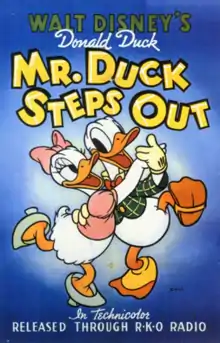Mr. Duck Steps Out
Mr. Duck Steps Out is a Donald Duck cartoon made by The Walt Disney Company. The film was released on June 7, 1940 and featured the debut of Daisy Duck.[1] The short was directed by Jack King and written by Carl Barks, Chuck Couch, Jack Hannah, Harry Reeves, Milt Schaffer, and Frank Tashlin.
| Mr. Duck Steps Out | |
|---|---|
 Theatrical release poster | |
| Directed by | Jack King |
| Produced by | Walt Disney |
| Story by | Carl Barks Chuck Couch Jack Hannah Harry Reeves Milt Schaffer Frank Tashlin |
| Starring | Clarence Nash |
| Music by | Charles Wolcott |
| Animation by | Les Clark Larry Clemmons Don Towsley Lee Morehouse Rex Cox Volus Jones Emery Hawkins Ray Patin Ken Muse Dick Lundy Phil Duncan Judge Whitaker Jim Armstrong |
| Layouts by | Bill Herwig |
| Color process | Technicolor |
Production company | |
| Distributed by | RKO Radio Pictures |
Release date | June 7, 1940 |
Running time | 8:12 minutes |
| Country | United States |
| Language | English |
Clarence Nash performs all the voices in the film—Donald, Daisy and Donald's nephews.
Plot
Donald visits the house of his new love interest, Daisy, for their first known date. Donald tried to woo her and hug her, but at first Daisy acts shy and has her back turned to her visitor. But Donald soon notices her tail feathers taking the form of a hand and signaling for him to come closer. But their time alone is soon interrupted by Huey, Dewey, and Louie who have just followed their uncle and clearly compete with him for the attention of Daisy.
Donald and the nephews take turns dancing the jitterbug with her while trying to get rid of each other. In their final effort the three younger ducks feed their uncle maize in the process of becoming popcorn. The process is completed within Donald himself who continues to move wildly around the house while maintaining the appearance of dancing. The short ends with an impressed Daisy showering her new lover with kisses.

History
The short stands out among other Donald shorts of the period for its use of modern music and surreal situations throughout. After this short, the idea of a permanent love interest for Donald was well established. However, Daisy did not appear as regularly as Donald himself.
Releases
- 1940 – Theatrical release
- 1961 – Walt Disney's Wonderful World of Color, episode #8.6: "Inside Donald Duck" (TV)
- 1977 – Donald and His Duckling Gang (theatrical)
- c. 1983 – Good Morning, Mickey!, episode #61 (TV)
- 1984 – "From Disney, With Love" (TV)
- 1984 – "Cartoon Classics - Limited Gold Edition: Daisy" (VHS)
- c. 1992 – Mickey's Mouse Tracks, episode #31 (TV)
- c. 1992 – Donald's Quack Attack, episode #45 (TV)
- 1994 – "Love Tales" (VHS)
- 1997 – The Ink and Paint Club, episode #1.20: "Huey, Dewey & Louie" (TV)
- 1998 – The Ink and Paint Club, episode #1.40: "Crazy Over Daisy" (TV)
- 2004 – "Mickey and Minnie's Sweetheart Stories" (DVD)
- 2004 – "The Chronological Donald" (DVD)
- 2006 – "Classic Cartoon Favorites: Best Pals - Donald and Daisy" (DVD)
- 2019 – Disney+ (Streaming)
References
- Lenburg, Jeff (1999). The Encyclopedia of Animated Cartoons. Checkmark Books. pp. 74–76. ISBN 0-8160-3831-7. Retrieved 6 June 2020.
- Douglas L. McCall, Film Cartoons: A Guide to 20th Century American Animated Features and Shorts, McFarland, 2015, p. 166.